Honor guard

An honor guard, or ceremonial guard, is a ceremonial unit, usually military in nature and composed of volunteers who are carefully screened for their physical ability and dexterity. Only those persons who are highly motivated and maintain exceptionally high standards of appearance and conduct and show aptitude for ceremonial duty are likely to be considered.
A primary role for honor guards in the United States and some other countries is to provide funeral honors for fallen comrades and to guard national monuments. An honor guard may also serve as the "guardians of the colors" by displaying and escorting the national flag on ceremonial occasions at official state functions. Also, certain religious bodies, especially Churches of the Anglican Communion and the Methodist movement, have the tradition of an Honor Guard at the funeral of an ordained elder, in which all other ordained elders present "guard the line" between the door of the church and the grave, or hearse if the deceased is to be buried elsewhere or cremated.[1]
Finally, honor guards usually provide detachments for review by visiting heads of state. Honor guards also serve in the civilian world for fallen police officers and other civil servants. Persons serving in this capacity may or may not be designated, meaning they may not be assigned to serve each and every time there is a funeral in their jurisdiction. In the USA, military honor guards may serve as ambassadors to the public, presenting a positive image of their service, and assisting with the recruiting effort.
Honor guards around the world
Commonwealth of Nations
In member states of the Commonwealth of Nations, a military guard mounted for ceremonial events is known as a guard of honour.
Argentina
Regiment of Mounted Grenadiers (Argentina). Still serving as part of the Argentine Army, they are the presidential guard and ceremonial companions. Two unmounted grenadiers are stationed in front of the Pink House as a symbol of the ceremonial and honor guard.
Brazil
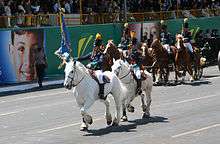
The Brazilian armed forces and police have several troops for ceremonial usages. The most important of them is the Brazilian president's honor guard. It is composed of the 1st Guards Cavalry Regiment (1o Regimento de Cavalaria de Guardas – RCG, in Portuguese) – "Independence Dragoons", the Presidential Guard Battalion (Batalhão da Guarda Presidencial – BGP, in Portuguese) and the Cayenne Battery.
Bulgaria
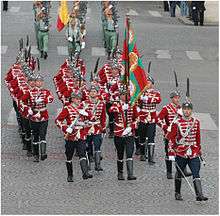
National Guards Unit (Bulgarian: Национална гвардейска част) includes military units for army salute ceremonials, a band and a wind orchestra. In 2001 the National Guards Unit was declared the official military unit representing the Bulgarian Army and one of the symbols of modern state authority along with the flag, the coat of arms and the national anthem.[2]
China (People's Republic of China)
Honor guards, as known as Combined Honor Guard of the People's Liberation Army, are provided by the Beijing Capital Garrison Command in Beijing, under the Central Theater Command and reporting directly to the General Staff. They marched as the first division in the military parade of the 35th, 50th, and 60th anniversaries of the People's Republic of China. They are often on parades led by a color guard detail carrying the PLA flag.
Colombia
The 37th Infantry Presidential Guard Battalion, composed of five companies, a historical company and one artillery battery plus a military band, a fanfare trumpet section and Corps of Drums, is the President of Colombia's honor guard service regiment under the National Army of Colombia. It is stationed at the Casa de Nariño in Bogota and carries the traditions of Simon Bolivar's infantry guards company raised in the midst of the Spanish American wars of independence in 1815.
Croatia
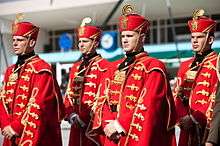
In Croatia, the Honor Guard Battalion (Croatian: Počasno-zaštitna bojna) serves as the guard of honor. The Honor Guard Battalion performs protocol tasks for the needs of top-level state and military officials, as well as tasks related to the protection and security of the Commander-in-Chief (President of the Republic of Croatia). It consist of up to 300 members. The unit is under direct command of the General Staff of the Armed Forces of the Republic of Croatia.[3]
Czech Republic
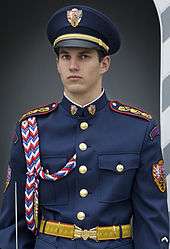
Ceremonial duties are usually served by the Castle Guard, a special unit of the armed forces of the Czech Republic, organized under the Military Office of the President of the Czech Republic, directly subordinate to the President of the Republic.
France
The Republican Guard of the French Gendarmerie provides both foot and horse-mounted guards of honor.
Germany

The primary mission of the Wachbataillon is to perform the military honors for the German Federal President, Federal Chancellor, Federal Minister of Defense and the Inspector General of the Bundeswehr during state visits or on similar occasions. In addition, the Wachbataillon takes part in military events and ceremonies of major importance. A secondary mission is to perform ceremonial guard duty at the Ministry of Defense and other high-profile public places, and protect and guard the members of the German government and the Ministry of Defense.
Greece
In Greece, the Presidential Guard is an elite unit of the Greek Army having the privilege to guard the Monument of the Unknown Soldier and the Presidential Palace. Its members, mostly known as Evzones must be taller than 1.85m and are trained hard as their duty includes standing completely still for more than an hour 4 times a day. They are famous for their military discipline, the ability to stand motionless without even blinking, their stylish walking and the uniform which derives from all the wars Greece has participated in.
Hungary

The Honor Guard in Hungary was the HDF 32nd Budapest Guard and Ceremonial Regiment (Hungarian: 'MH 32. Budapest Őr- és Díszezred') until 31 December 2006, at which time it was disbanded. From 1 January 2007 was the Ceremonial Battalion branch, part of the MH Támogató Dandár (MH TD, HDF Support Brigade) until 31 December 2010. Converted from 1 January 2011 to Nemzeti Honvéd Díszegység (National Home Defense Ceremonial Band) as part of the MH TD and achieved the service from 25 April.[4][5]
Iran
Italy
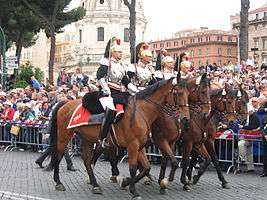
In Italy the unit institutionally intended to act as an honor guard to the President of the Italian Republic is the Corazzieri Regiment, a special branch of the Carabinieri. The Corazzieri follow the President during official occasions and are also partly responsible for the internal security of the Quirinal Palace. In addition to the Corazzieri, there are other honor units chosen from the different Armed Forces, specifically for representation purposes. These units have to stand guard at important places, such as the gates of the seats of the Chamber of Deputies and the Senate, at the Tomb of the Unknown Soldier in the Altar of the Homeland, and at the gates of the Quirinal Palace.
Example of honor units from the different Armed Forces are:
- Italian Army:
- Honor Company "Goito" from the 1° Regiment "Granatieri di Sardegna";
- Honor Squadron from the 8° Regiment "Lancieri di Montebello";
- Italian Navy:
- Italian Air Force:
During state funerals, honor guards are granted to the departed by the protocol.[6] The guards are positioned at the entrance and the exit of the place in which the ceremony is held. Aside from the aforementioned services, honor guards are also found within the Guardia di Finanza and the Polizia di Stato. They perform the same duties mentioned above.
Macedonia
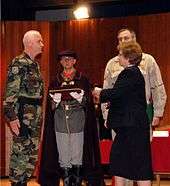
The Macedonian Guard (македонска гарда, makedonska garda) is part of the Army of the Republic of Macedonia which is mainly used for ceremonial purposes. It is the personal guard of the President of the Republic of Macedonia. The National Guard can be often seen near the presidential palace, during official visits of foreign presidents or delegations, ceremonies and during the days of the flag. In 2010 the Ministry of Defence proposed and designed new uniforms for the guards. Both, the old and the new uniforms, are based on the uniforms of the Internal Macedonian Revolutionary Organization (IMRO) revolutionaries with some details of the other periods of the history of the Republic of Macedonia. Influence over the new design were based on the uniform worn by revolutionary Dedo Iljo Maleshevski, ancient Macedonian uniforms and the uniforms of the 19th century Ukrainian Macedonian regiment which served in the Imperial Russian Army.[7]
Mexico
The Honor Guard in Mexico consists of members selected from the Navy, Army or Air Force, and report to the Secretariats of National Defense and the Navy, while the Estado Mayor Presidencial maintains, through the Army Presidential Guards Corps, a dedicated guards brigade. Some of their duties include protection of the Mexican flag in Zocalo, and the raising and lowering of it, as well as providing ceremonial guards during state visits to Mexico. There are also those selected from other organizations, such as historic societies, schools, sports centers, celebrities, etc. Escolta de la bandera or Escolta de guerra or Escolta de honores or simply La escolta is the term in Spanish for color guards and flag parties.
Philippines
The Presidential Security Group provide honor guard services to the President of the Philippines in Malacanang Palace, especially during state visits to the country. The PSG is the only presidential guard service in Asia that is composed of men and women from the various uniformed organizations of the Philippines: the Armed Forces of the Philippines, the Philippine National Police, the Bureau of Fire Protection and the Philippine Coast Guard.
The AFP has 5 designated honor guard battalions mandated for public duties for events concerning the Armed Forces. They are:
- General Headquarters Security & Escort Battalion, AFP General Headquarters and Headquarters Service Command
- Security and Escort Battalion, Philippine Army
- Headquarters Philippine Navy & Headquarters Support Group, Philippine Navy
- Marine Security and Escort Group, Philippine Marine Corps
- Air Force Special Security Group, Philippine Air Force
Honor Guard units are also present in the PNP and the PCG, and are mounted on important occasions of these two services.
Poland
The Honor Guard unit in Poland is the Batalion Reprezentacyjny Wojska Polskiego (Ceremonial Battalion of the Polish Armed Forces) from 1 January 2001.[8]
Also posted within its ranks is the Mounted Ceremonial Troop of the Armed Forces, which also acts as an honor guard and horse guard unit.
Service branches of the Armed Forces and other civil uniformed services maintain honor guard units of their own.
Romania
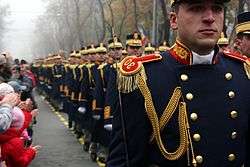
The Regimentul 30 Gardă „Mihai Viteazul” (30th Guard Regiment "Michael the Brave") of the Romanian Land Forces serves as the honor guard regiment of the Romanian Armed Forces. The regiment is present at ceremonial events and during visits from international officials. The Romanian Gendarmerie maintain an honor guard company and a horse guards troop acting during state ceremonies and celebrations of the service.
Russia
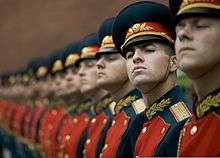
Russia's primary honour guard is the Kremlin Regiment of the Federal Protective Service of the Russian Federation, established in 1936. The 154th Preobrazhensky Independent Commandant's Regiment, established in 1979, serves as the official honor guard regiment of the Russian Armed Forces and serves as the main honor guard unit of the armed forces. Military districts and fleet formations of the Russian Navy also have their own honor guard companies.
Serbia
The Serbian Guard Unit is an elite unit within the Serbian Army, of brigade size, under the direct command of Serbian Armed Forces Chief of Staff. Its purpose to secure vital facilities of the defense system and performing military honors to highest foreign, domestic and military officials. For the needs of Ministry of Defence and the Serbian Army General Staff, the Guard Unit performs tasks within the scope of the military police work and the tasks in the field of logistics and security. Guard continues the tradition of Serbian Guard units which is now almost two centuries long. The first Guard unit formed in Serbia was created on the order of Prince Milos Obrenovic on St. George Day in 1830 in Pozarevac. The Guard Unit also sports the official military band of the Serbian Armed Forces - the Guards Band.
South Korea
.jpg)
South Korea operates several honour guards - one each from the Republic of Korea Army, Republic of Korea Navy, Republic of Korea Air Force and Republic of Korea Marine Corps, along with a traditional honor guard unit. The traditional guard in particular was founded in 1991 after president Roh Tae-woo reviewed the Old Guards of the United States. Since then the traditional honour guards have taken the role of officially welcoming heads of state and other dignitaries. Roles of the honour guards as a whole include funeral honours for the fallen, ensuring the security of various military headquarters, and acting as ceremonial guards to Gyeongbok Palace.
For ceremonial purposes the guards carry various rifles - the Army, Navy and Air Force carry the M16 rifle; the Marine Corps carry M1 Garands and the traditional guards carry ceremonial swords, arrows, spears and lances, keeping with the traditions of the Korean military and as a tribute to the guards units of the Imperial era. While the service guards units maintain their respective military bands based on the US and UK practices, the traditional guard unit also contains a Daechwita, a form of military band playing Korean traditional music for military ceremonies and events, and as such wears uniforms used by similar ensembles in the 19th century.
Sweden

Honor guard service is carried out by all units of the Swedish Armed Forces, although the Life Guards regiment (Livgardet) in the Swedish Army accounts for the main part of honor guard services. The Royal Guards (Högvakten) at the Stockholm Palace and the Drottningholm Palace is the honor guard to the King of Sweden. The service is carried out by the Life Guards as well as other units of the Swedish Armed Forces including the Home Guard and other voluntary defence organisations.
The Grenadier company of the Life Guards is used as an honor guard at state visit welcoming ceremonies. A detachment of grenadiers is also used as honor guard at the opening of the Riksdag, when an incoming foreign ambassador meets with the King at an audience to present letters of credence and when the King attends an annual meeting of one of the Royal Academies.
Drabantvakt ("Royal Bodyguard"), commonly known as Karl XI:s drabanter ("The Bodyguard of Charles XI") and Karl XII:s drabanter ("The Bodyguard of Charles XII") is a ceremonial guard used at state occasions such as state visits, investiture of a monarch, royal weddings and funerals etc. The guard was formed in 1860 based on historical royal bodyguards. The design of the uniforms of the guard is inspired by, but not identical to uniforms used during the reign of Carles XI and Charles XII respectively. The guard consists of 24 soldiers and one officer selected from the Life Guards.
Taiwan (Republic of China)
In the Republic of China, the honor guard is provided by members from the three service branches of the Republic of China Armed Forces, including the ROC Army, ROC Navy and the ROC Air Force, usually present at the places as follows:
- The Chiang Kai-shek Memorial Hall in Taipei
- The Sun Yat-sen Memorial Hall in Taipei
- The National Revolutionary Martyrs' Shrine in Taipei
- The Cihu Presidential Burial Place in Taoyuan
- The Daxi Presidential Burial Place in Taoyuan
Turkey
Until its 2016 disbandment the Presidential Guard Regiment of Turkey acted as an honor guard regiment of the Turkish Armed Forces.[9]
United States
Each military branch has its own honor guard: Army, Marines, Navy, Air Force, and Coast Guard. Most state national guard units have a ceremonial guard as well. The official honor guard of every branch is based in Washington, D.C., though nearly every military installation will have its own honor guard for local ceremonies and events. The honor guard units in Washington, D.C. represent the military as a whole and the United States as a nation, and perform numerous ceremonies on behalf of the President of the United States. The U.S. 3rd Infantry Regiment (The Old Guard) is the preeminent honor guard, being the Presidential guard.
Arlington National Cemetery's Tomb of the Unknowns is guarded by members of the U.S. 3rd Infantry Regiment (The Old Guard).
Many local, state/provincial, national and federal public safety agencies maintain Honor Guards, Pipes & Drums and Buglers, including fire departments, law enforcement agencies, emergency medical services, and search and rescue, who typically use adaptations of military honor guards, and honor those who die in the line of duty (LODD-Line of Duty Death), off-duty but still on the job, and retirees, as well as participating in support of other agencies, and parades. Some Law Enforcement agencies are able to maintain a Rifle Team for 'three volley' salutes. Most, even those within major career paid agencies, are not paid for performing and preparing for the honor guard duty.
Vietnam
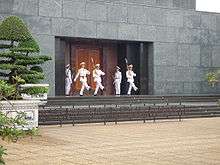
Two honor guard units fall under the People's Army of Vietnam:
- General Staff of the Vietnam People's Army:
- Unit of Military Honor Guard: honor guard during visits of foreign leaders, National Day parade, Military Memory days...[10]
- Ministry of Defense:
- Command of Ho Chi Minh Mausoleum Honor Guard: protection of Ho Chi Minh Mausoleum [11]
See also
- Guard of honour
- Color guard
- Quarter guard
- Change of command (military)
- Military rites
- Vigil of the Princes
References
- ↑ Traditions of the United Methodist Church
- ↑ President of the Republic of Bulgaria, Official Website, National Guards Unit; accessed 28 February 2016.
- ↑ Dugoročni plan razvoja Oružanih snaga Republike Hrvatske za razdoblje 2015. do 2024. godine (Long-Term Development Plan of the Croatian Armed Forces for the period 2015-2024) (Croatian)
- ↑ Búcsúztak a harminckettesek, jobbik.net; accessed 26 January 2016. (Hungarian)]
- ↑ MH Támogató Dandár, parbeszed.hm.gov.hu; accessed 7 July 2015. (Hungarian)]
- ↑ "Protocol for State Funerals and National Mourning". Official website of the Italian Government – Department of State Ceremonies.
- ↑ Презентирани нови гардиски униформи- микс на Армани и дедо Иљо Малешевски; accessed 8 July 2015.(Macedonian)
- ↑ Batalion Reprezentacyjny Wojska Polskiego (Polish language wikiarticle)
- ↑ CNN, Faith Karimi and Isil Sariyucem. "Turkey to disband elite presidential guard unit". CNN. Retrieved 2016-09-24.
- ↑ Unit of Military Honor Guard; accessed 7 July 2015. (Vietnamese)
- ↑ Ho Chi Minh Mausoleum Honor Guard; accessed 7 July 2015. (Vietnamese)
External links
| Wikimedia Commons has media related to Honour guards. |
- United States Army Honor Guard
- United States Marine Corps Honor Guard
- United States Navy Ceremonial Guard
- United States Air Force Honor Guard
- United States Coast Guard Honor Guard